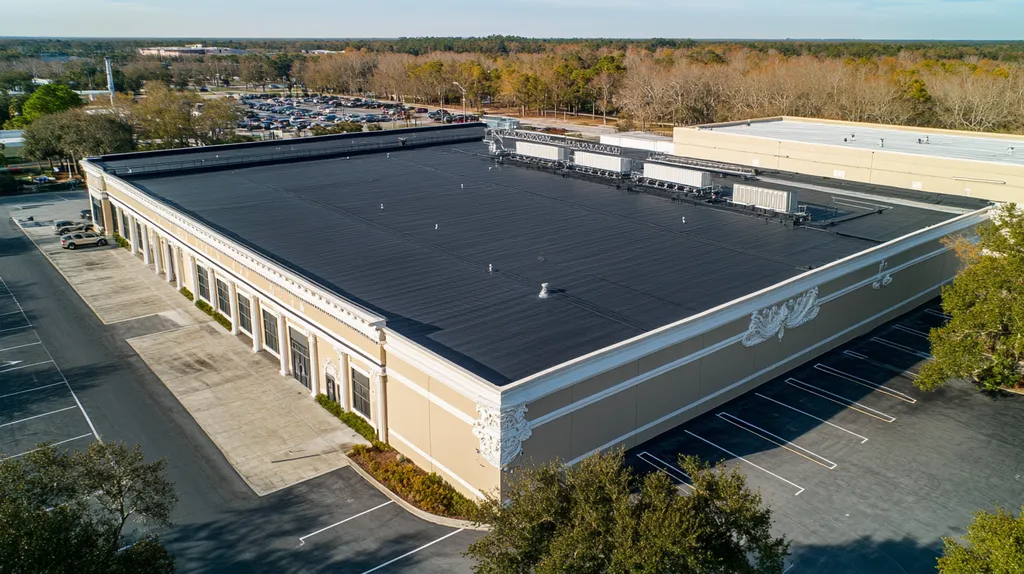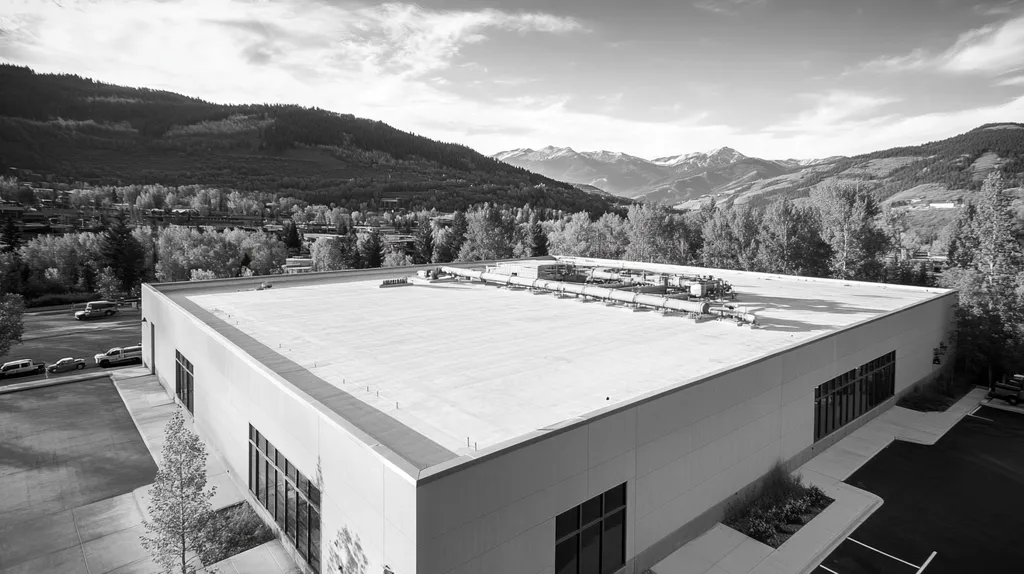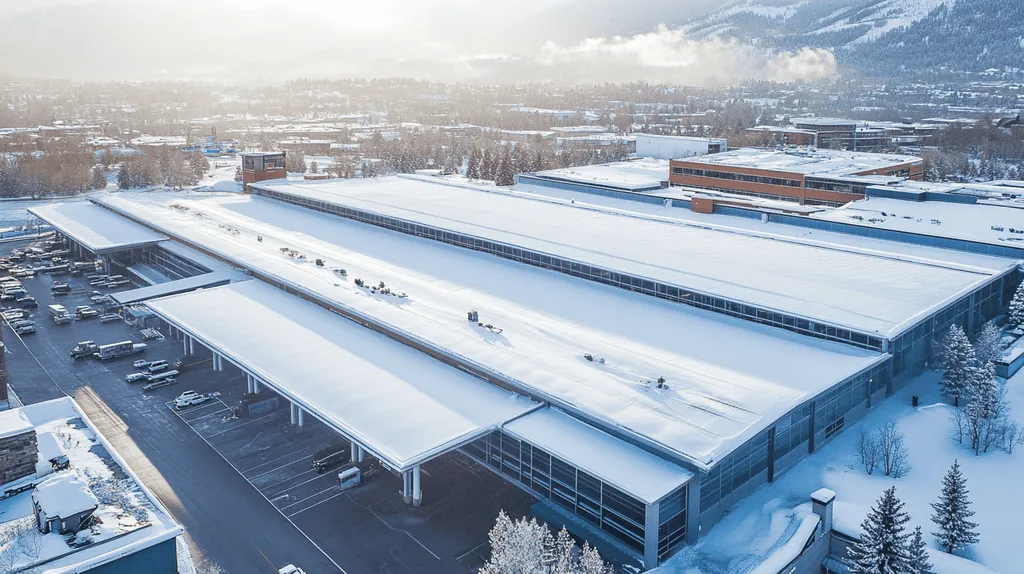Welcome to today’s Battle Royale featuring two roofing heavyweights: “TPO” in the east corner versus “PVC” in the west!
Tonight’s showdown pits these contenders against each other across six punishing rounds designed to test every aspect of their performance for Preventive Maintenance Plan for a Commercial Roof.
At stake? Millions in potential costs, decades of building protection, and the critical performance demands of modern commercial and industrial facilities.
Our professional judging panel will evaluate each round on technical merit, real-world performance, and value delivery. After all six rounds, we’ll declare our ultimate champion.
Ladies and gentlemen, facility managers and building owners… it’s time to rumble!
ROUND 1: INITIAL COSTS & INSTALLATION
In today’s volatile construction market, choosing between TPO and PVC roofing systems can impact a facility’s bottom line for decades. With commercial roof installations often exceeding $100,000, the stakes are high for property owners and facility managers. Understanding the nuances of material costs, installation requirements, and project timelines is crucial for making an informed decision that aligns with both immediate budget constraints and long-term facility goals.
Material Expenses
Initial material costs represent one of the most significant differences between TPO and PVC systems. TPO materials typically range from $4.50 to $6.00 per square foot installed, making it an attractive option for projects with tight budgets.
PVC materials generally command a premium, with costs ranging from $6.50 to $9.00 per square foot installed. This higher cost reflects PVC’s advanced chemical formulation and enhanced durability characteristics.
Regular inspections of both systems are crucial for maintaining warranty compliance and identifying potential issues early. Professional assessments should occur semi-annually and after major weather events to prevent costly repairs. (source: Travelers Insurance)
Based purely on material costs, TPO holds a clear ADVANTAGE in this category, offering significant upfront savings without sacrificing basic performance requirements.
Installation Complexity
Installation procedures significantly impact both initial costs and long-term performance. TPO installation typically requires less specialized training and fewer custom details, allowing for faster completion with standard roofing crews.
PVC installation demands more precise techniques, particularly around seams and penetrations. The material’s rigid nature requires experienced installers with specific training in PVC welding and detail work.
While both systems require careful attention to manufacturer specifications, PVC’s more complex installation process often results in higher labor costs and increased potential for installation errors.
TPO’s simpler installation requirements give it an ADVANTAGE in this category, particularly for projects where skilled labor availability is limited.
Project Timeline
Project duration directly affects facility operations and overall costs. TPO installations typically progress 20-30% faster than comparable PVC projects, minimizing business disruption and reducing labor expenses.
PVC installations require additional time for precise detail work and proper curing of welded seams. This extended timeline can impact scheduling and coordination with other trades.
Weather sensitivity affects both systems equally, but TPO’s faster installation process provides more flexibility in scheduling around optimal conditions.
The efficiency of TPO installation gives it another clear ADVANTAGE in timeline considerations.
ROUND 1 WINNER: TPO
ROUND 2: DURABILITY & LIFESPAN
When evaluating commercial roofing systems, durability and lifespan considerations can make or break a facility’s maintenance budget. With replacement costs often exceeding $250,000 for a typical 20,000-square-foot roof, the stakes are significant. Property owners must carefully weigh how TPO and PVC membranes perform over time, particularly in challenging environments where material degradation can accelerate rapidly.
Material Resilience
TPO membranes demonstrate excellent resistance to UV radiation and general weathering, with most systems maintaining their reflective properties for 15-20 years. Their flexible composition helps absorb building movement and thermal shock without compromising structural integrity.
PVC roofing exhibits superior chemical resistance and maintains its performance characteristics even when exposed to harsh industrial emissions or grease exhaust. This material’s proven track record in demanding environments spans over four decades.
Regular inspections of both systems help prevent premature aging and maintain warranty compliance. Professional assessments should occur twice yearly and after severe weather events to document material condition and address emerging issues. (source: Xenia Team)
Given its exceptional chemical resistance and longer performance history, PVC earns an ADVANTAGE in material resilience.
Weather Performance
TPO systems offer strong resistance to temperature extremes and maintain flexibility in cold conditions. The membrane’s heat-welded seams create a monolithic surface that effectively sheds water and resists wind uplift.
PVC roofing delivers outstanding performance in all climate zones, particularly excelling in areas with frequent precipitation or temperature swings. Its hot-air welded seams remain watertight even under ponding conditions.
While both materials handle typical weather conditions well, PVC’s proven track record in extreme environments gives it an ADVANTAGE in this category.
Lifecycle Expectations
TPO roofing systems typically last 20-25 years when properly maintained. Their performance can be extended through regular maintenance and prompt repairs of any damage.
PVC membranes regularly achieve 25-30 year lifespans, with some installations exceeding three decades of service. This extended durability often justifies their higher initial cost through reduced replacement frequency.
While both systems offer respectable service lives, PVC’s longer average lifespan and proven longevity record earn it another ADVANTAGE in this category.
ROUND 2 WINNER: PVC
ROUND 3: PERFORMANCE FACTORS
Performance factors can make or break a commercial roofing investment, with poor material choices leading to repair costs exceeding $50,000 annually. Modern commercial roofs must withstand increasingly extreme weather conditions while maintaining energy efficiency and chemical resistance. Understanding how TPO and PVC systems perform across these critical factors helps facility managers avoid costly mistakes and premature replacements.
Durability
A commercial roof’s durability directly impacts maintenance costs and replacement frequency. TPO membranes provide strong UV resistance and maintain flexibility across temperature extremes, typically delivering 15-20 years of reliable service.
PVC roofing systems demonstrate exceptional durability under harsh conditions, regularly achieving 20-25 year lifespans. Their proven track record in demanding environments includes superior resistance to thermal cycling and structural movement.
A proactive maintenance approach significantly extends the lifespan of both systems while ensuring warranty compliance and reducing long-term costs. (source: Xenia Team)
Given its longer average lifespan and proven performance history, PVC earns an ADVANTAGE in durability.
Energy Efficiency
TPO membranes excel in reflecting solar radiation, with white surfaces reflecting up to 87% of sunlight. This high reflectivity translates to reduced cooling costs and improved building energy performance.
PVC systems offer comparable reflective properties, with premium formulations achieving similar solar reflection rates. Their sustained reflectivity helps maintain energy efficiency benefits throughout the membrane’s lifespan.
Both materials provide excellent energy performance and contribute equally to building sustainability goals, resulting in a TIE for this category.
Chemical and Puncture Resistance
TPO provides adequate resistance to common environmental contaminants but can show vulnerability to certain industrial chemicals and oils. Its puncture resistance varies significantly between manufacturers and membrane thicknesses.
PVC membranes deliver superior chemical resistance across a broader range of substances, particularly excelling against industrial pollutants, grease, and animal fats. Their inherent toughness also provides enhanced puncture resistance.
PVC’s comprehensive chemical resistance and superior puncture protection give it a clear ADVANTAGE in this category.
ROUND 3 WINNER: PVC
ROUND 4: MAINTENANCE REQUIREMENTS
Maintenance oversights on commercial roofs can transform minor issues into catastrophic failures, with repair costs often exceeding $100,000. Poor maintenance practices account for 80% of premature roof failures, making the choice between TPO and PVC crucial for long-term facility management. Understanding the specific maintenance demands of each system helps property managers optimize their maintenance budgets and prevent costly emergency repairs.
Routine Inspections
TPO membranes require semi-annual professional inspections to maintain warranty coverage. Their light-colored surface makes visual inspections more effective, allowing maintenance teams to spot potential issues early.
PVC systems demand quarterly inspections due to their more complex seam construction and chemical resistance properties. Their darker surface can make visual identification of problems more challenging.
Both systems require immediate inspection following severe weather events or nearby construction activity to prevent minor damage from escalating into major failures. (source: Travelers Insurance)
TPO’s easier inspection requirements and better visibility give it an ADVANTAGE in this category.
Cleaning Requirements
TPO membranes maintain their reflective properties with minimal cleaning intervention. Most installations require only annual power washing to remove surface contaminants and maintain energy efficiency.
PVC roofing typically needs more frequent cleaning to prevent chemical buildup and maintain its protective properties. Quarterly cleaning is often necessary, especially in industrial environments or areas with high pollution levels.
The reduced cleaning frequency and simpler maintenance protocols for TPO systems provide another clear ADVANTAGE in this category.
Repair Procedures
TPO repairs can often be completed using standard heat-welding equipment and readily available materials. Most maintenance teams can address common issues without specialized training.
PVC repairs require specific welding temperatures and techniques, often necessitating specialized contractors. The material’s rigid nature makes patch work more challenging and time-consuming.
While both systems can be effectively repaired when properly maintained, TPO’s simpler repair requirements give it an ADVANTAGE in this category.
ROUND 4 WINNER: TPO
ROUND 5: SUSTAINABILITY CREDENTIALS
With environmental regulations tightening and green building certifications becoming mandatory in many jurisdictions, roofing material sustainability now directly impacts property values and operating costs. Poor material choices can result in hefty environmental compliance fines exceeding $50,000 and significantly reduced property marketability. Modern facility managers must carefully evaluate how TPO and PVC systems align with increasingly stringent sustainability requirements.
Environmental Impact
TPO roofing materials consist primarily of thermoplastic polyolefin compounds that require minimal energy during production. Their manufacturing process generates fewer harmful byproducts compared to alternative materials, reducing the overall environmental footprint.
PVC production involves chlorine-based compounds that create more significant environmental concerns during manufacturing. While modern facilities have reduced these impacts, PVC still generates more greenhouse gases during production than TPO.
Both materials can be installed using low-VOC adhesives and heat-welding techniques that minimize on-site emissions and protect worker health. Proper material selection and installation planning significantly impact long-term environmental performance and compliance costs. (source: Holcim Elevate)
Given its cleaner production process and reduced environmental impact, TPO earns an ADVANTAGE in this category.
Recyclability and Reuse
TPO membranes can be fully recycled at the end of their service life, with many manufacturers operating take-back programs. The recycled material finds new life in various construction products, reducing landfill waste and raw material demand.
PVC recycling faces greater challenges due to its chemical composition and the presence of plasticizers. While technically recyclable, fewer facilities accept used PVC roofing materials, resulting in more material ending up in landfills.
TPO’s superior recyclability and established recycling infrastructure give it another clear ADVANTAGE in this category.
Energy Performance
TPO’s highly reflective surface maintains its solar reflectance index (SRI) rating with minimal degradation over time. This sustained performance helps reduce cooling costs and urban heat island effects throughout the membrane’s lifespan.
PVC systems offer comparable initial reflectivity but may experience more significant degradation of these properties over time. Their energy performance can decline more rapidly in harsh environments or areas with high pollution levels.
While both materials provide strong energy benefits when new, TPO’s better long-term reflective performance earns it an ADVANTAGE in this category.
ROUND 5 WINNER: TPO
ROUND 6: SPECIALIZED APPLICATIONS
In specialized commercial roofing applications, material selection can mean the difference between a thriving facility and catastrophic failure costing upwards of $500,000. Modern buildings increasingly incorporate rooftop gardens, solar installations, and equipment-heavy mechanical zones. Each specialized use creates unique demands that test the limits of roofing materials, making the choice between TPO and PVC particularly critical for long-term success.
Rooftop Gardens
Green roof installations require membranes capable of withstanding constant moisture exposure and aggressive root systems. TPO systems need extensive protective layers and root barriers, significantly increasing installation complexity and costs.
PVC membranes offer inherent resistance to root penetration and superior puncture protection. Their chemical formulation naturally resists biological growth and stands up to constant moisture exposure without additional protective layers.
Regular inspections of both systems help prevent potential issues, particularly around drainage points and penetrations. Early detection of membrane stress or damage can prevent catastrophic failures and protect valuable plantings.
PVC’s superior biological resistance and reduced need for protective layers gives it a clear ADVANTAGE in green roof applications.
Extreme Weather Conditions
In regions experiencing severe weather events, membrane performance becomes critical to building protection. TPO systems offer good UV resistance but can become brittle over time when exposed to extreme temperature fluctuations.
PVC roofing maintains its flexibility and performance characteristics even under harsh conditions. Its superior chemical stability and stronger welded seams provide better protection against driving rain and high winds.
The proven track record of PVC in extreme environments gives it another ADVANTAGE in this category.
Heavy Foot Traffic Areas
Commercial roofs with frequent maintenance traffic require exceptional puncture and tear resistance. TPO membranes typically need additional walk pad protection in high-traffic areas, increasing maintenance costs and installation complexity.
PVC’s greater thickness and inherent durability provide better resistance to repetitive foot traffic. Its superior puncture resistance often eliminates the need for additional protective layers around mechanical equipment and service paths.
For areas with heavy foot traffic, PVC earns another clear ADVANTAGE due to its superior durability and reduced need for supplemental protection.
ROUND 6 WINNER: PVC
AND THE WINNER IS…
After six grueling rounds of technical analysis, with championships on the line and millions in potential costs at stake, we have our verdict!
In a split decision that went the distance, PVC claims victory with wins in three crucial categories: Durability & Lifespan, Performance Factors, and Specialized Applications. PVC’s superior chemical resistance, proven longevity, and exceptional performance in demanding environments helped secure its championship status.
But don’t count TPO out! This formidable challenger dominated in Initial Costs & Installation, Maintenance Requirements, and Sustainability Credentials. For projects where budget constraints and environmental impact take center stage, TPO remains a compelling choice.
Remember, folks – every building brings its own unique requirements to the ring. Local climate conditions, facility usage patterns, and specific property characteristics can dramatically impact performance. While this analysis provides general guidance, it can’t account for all variables in your corner of the commercial property world.
Before making your final decision, consult with qualified roofing professionals who can evaluate your specific situation. They’ll help ensure your choice goes the distance for your facility.
In the high-stakes arena of commercial roofing, true victory comes not from blindly backing the champion, but from strategically matching your building’s unique demands with the right contender’s strengths. Choose wisely – your facility’s future is on the line!
FREQUENTLY ASKED QUESTIONS
Q. What are the initial costs of a commercial roof installation?
A. Initial costs vary significantly between materials like TPO and PVC. TPO is generally cheaper, ranging from $4.50 to $6.00 per square foot. In contrast, PVC costs between $6.50 and $9.00 per square foot, reflecting its enhanced durability.
Q. How do TPO and PVC compare in terms of durability for industrial roofs?
A. PVC membranes are generally more durable than TPO options. They offer superior resistance to harsh chemicals and can last up to 30 years. TPO typically lasts 20-25 years but performs well under normal conditions.
Q. What performance factors should I consider for a commercial roof?
A. Key performance factors include durability, energy efficiency, and chemical resistance. TPO provides strong UV resistance while PVC excels in chemical resilience, making it suitable for harsher environments. Choose based on your facility’s specific needs.
Q. What are the maintenance requirements for TPO versus PVC commercial roofs?
A. TPO requires semi-annual inspections, while PVC needs quarterly checks. TPO is easier to maintain because its surface allows for better visual inspections. Regular maintenance is essential to prolong the lifespan of both materials.
Q. Which roofing material is more sustainable for commercial use?
A. TPO is considered more sustainable due to its cleaner production process and recyclability. Conversely, PVC production generates more greenhouse gases. Both materials can contribute to energy efficiency if properly maintained.
Q. Which roofing option is better for specialized applications?
A. PVC is often better for specialized applications like rooftop gardens and extreme weather. Its resistance to punctures and moisture makes it a reliable choice for demanding environments, unlike TPO which may require additional protective layers.
Q. How can I extend the lifespan of my commercial roof?
A. Regular inspections and maintenance play crucial roles in extending lifespan. Engaging professionals for semi-annual checks, timely repairs, and keeping surfaces clean can significantly reduce deterioration. Proper maintenance ensures both TPO and PVC last their optimal durations.











